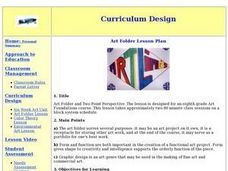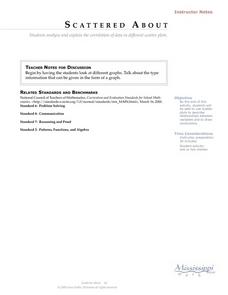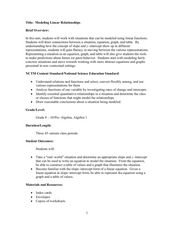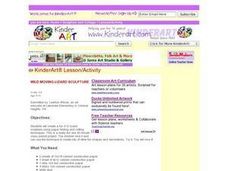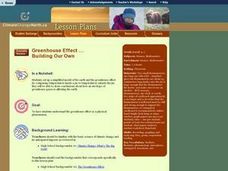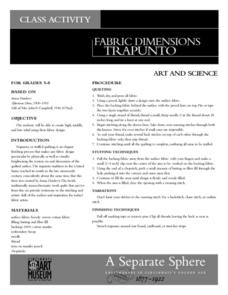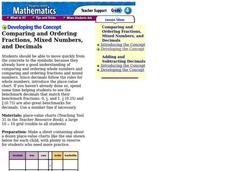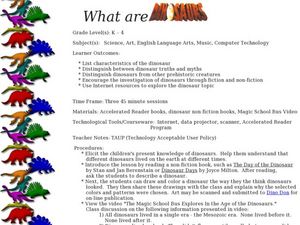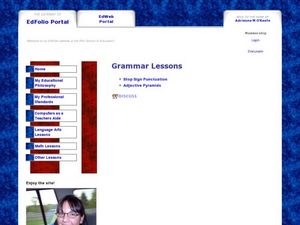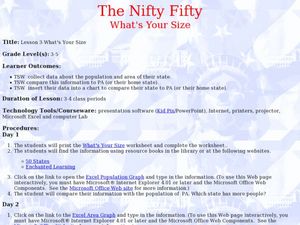Curated OER
Art Folder and Two Point Perspective
Eighth graders examine how to create a 3-D effect on a flat surface and draw in two-point perspective. They view and discuss elements of design, analyze artwork by M.C. Escher and Roy Lichtenstein, and design and create an art folder.
Curated OER
Third Grade Fraction/Promethean Flip Chart
While just a simple exploration of fractions, this lesson comes with resources to make it a richer experience. Third graders identify fractions, complete worksheets, and use KidPix to make their own fraction pizzas.
Curated OER
Scattered About
Students are introduced to the concept of scatter plots after reviewing the various types of graphs. In groups, they analyze the type of information one can receive from a scatter plot and identify the relationship between the x and y...
Curated OER
Modeling Linear Relationships
Students graph lines using the slope and y-intercept. In this algebra lesson, students create data using tables and equations. They use their data to make predictions and draw conclusion.
Curated OER
Prairie Senses
Second graders use their senses to explore a prairie or imaginary prairie. They draw pictures to represent the five senses and discover how an artist describes non-visual sensations in a visual way.
Curated OER
Wild Moving Lizard Sculpture
Lizards are amazing! After a instructional activity on reptiles, take a look at this set of instructions. You'll be able to guide your class in making a paper lizard sculpture that moves. This idea also includes variations on the paper...
Curated OER
Greenhouse Effect ...Building Our Own
Young scholars explore the greenhouse effect. They set up a simplified model of the earth and the greenhouse effect. Students compare temperatures inside a jar to temperatures outside the jar. Pupils collect information and create a line...
Curated OER
Fabric Dimensions
Students create original examples of the trapunto quilting technique in this middle-level lesson sutied for the Art classroom. Assessment and discussion questions are included for this lesson.
Curated OER
Fractions: Jim and John
Elementary and secondary learners investigate various concepts related to the study of fractions. They use word problems during the introduction to parts of a fraction and proceed to some of the basic operations of using fractions. The...
Curated OER
Comparing and Ordering Fractions, Mixed Numbers, and Decimals
Young scholars practice comparing and ordering fractions, mixed numbers, and decimals. In this fractions, mixed numbers, and decimals instructional activity, students examine a decimal place value chart compared to a whole number place...
Curated OER
What are Dinosaurs?
Pupils explore the attributes of dinosaurs. In this dinosaur lesson, students read books and watch videos featuring dinosaurs. Pupils also research dinosaur traits using Internet sources.
Curated OER
Stop Sign Punctuation
Students use punctuation and capitalization. In this grammar lesson students use stop signs in the place of periods. Students cut out sentences and put stop signs in appropriate places. Students indicate capitalization where needed.
Curated OER
Informative Essay Writing
High schoolers start by drawing Mr. Essay Man, who is supposed to illustrate the different parts of an essay. After discussing what each component should contain, writers start their essay, guided by the teacher and class discussion....
Curated OER
The Big Circle
Students explore geography by participating in a mapping activity. In this concentric ring instructional activity, students utilize a poster board, string and markers to identify their current location within the entire world. Students...
Curated OER
How 'bout them bones!
After a lesson on the human skeleton, hand out a worksheet that requires learners to identify the pelvis, rib cage, skill, spine, and thigh bones. They draw a line from the name of the bone to its location on the skeleton. Tip: Instead...
Curated OER
Digger and the Gang
Help online friends Digger and Sprat from the BBC series to solve math problems! In a series of activities, your class will use data sets to calculate measurements, averages, means, and probabilities. The class completes worksheets and...
Curated OER
Growing a Seed
Seeing how seeds grow into plants is such an enjoyable for students! They plant lima bean seeds and take pictures to record the growth of their plants. Students write in a journal to describe their daily observations of their plants, and...
Curated OER
The Nifty Fifty-What's Your Size?
Learners explore state populations. In this state geography lesson, students use a variety of technology tools to research and graph population and area of assigned states.
Curated OER
Hypatia: Angles
Introduce your young geometers to Hypatia, the first noted Greek female mathematician, and the properties of angles. Though this resource is missing worksheets that are needed to complete the lesson, the structure is sound and learning...
Curated OER
Halves And Fourths
Young learners start out by going to the board to draw lines through shapes to identify halves. Then they are given a square of paper and are directed to fold the paper into halves and then into fourths. They color the halves...
Virginia Department of Education
Writing Counterarguments
This activity is better utilized as a peer-editing exercise and not as an activity on how to write counterarguments. Writers take their argumentative rough drafts, peer edit in groups of four, and review the author on common essay...
Curated OER
Seashore Explorers
There are three separate lessons within this resource that can be used together, or that can each stand alone. In the first, five simple activities allow junior scientists to examine the amazing properties of water. In the second, they...
Curated OER
Beautiful Birds
Students engage in a lesson that is about birds while taking part in a variety of activities that are like the following. They play a game that is used for increasing memory while using bird pictures. Students also create a collage with...
Curated OER
Graphs and Data
Students investigate poverty using graphs. In this algebra lesson plan, students collect data on the effects of poverty and use different rules to analyze the data. They graph and use the trapezoid rule to interpret the data.
